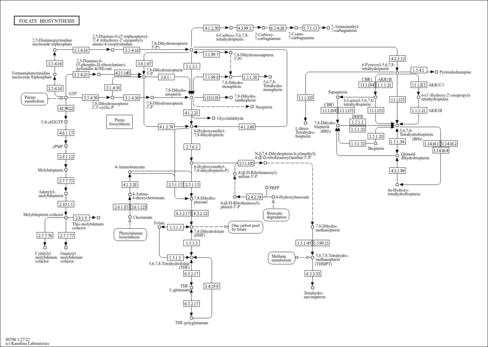| Record Information |
|---|
| Version | 1.0 |
|---|
| Created at | 2020-04-17 19:16:16 UTC |
|---|
| Updated at | 2020-11-18 16:39:28 UTC |
|---|
| CannabisDB ID | CDB005169 |
|---|
| Secondary Accession Numbers | Not Available |
|---|
| Cannabis Compound Identification |
|---|
| Common Name | 7,8-Dihydropteroic acid |
|---|
| Description | 7,8-Dihydropteroic acid, also known as dihydropteroinsaeure or H2PTE, belongs to the class of organic compounds known as pterins and derivatives. These are polycyclic aromatic compounds containing a pterin moiety, which consist of a pteridine ring bearing a ketone and an amine group to form 2-aminopteridin-4(3H)-one. 7,8-Dihydropteroic acid is a strong basic compound (based on its pKa). 7,8-Dihydropteroic acid exists in all living species, ranging from bacteria to humans. Outside of the human body, 7,8-Dihydropteroic acid has been detected, but not quantified in, several different foods, such as persian limes, common verbena, garden tomato, butternut squash, and romaine lettuces. This could make 7,8-dihydropteroic acid a potential biomarker for the consumption of these foods. A pteroic acid derivative arising from formal hydrogenation of the 7,8-double bond of pteroic acid. 7,8-Dihydropteroic acid is expected to be in Cannabis as all living plants are known to produce and metabolize it. |
|---|
| Structure | |
|---|
| Synonyms | | Value | Source |
|---|
| 4-(((2-Amino-1,4,7,8-tetrahydro-4-oxo-6-pteridinyl)methyl)amino)benzoic acid | ChEBI | | 7,8-Dihydropteroate | ChEBI | | Dihydropteroate | ChEBI | | Dihydropteroinsaeure | ChEBI | | 4-(((2-Amino-1,4,7,8-tetrahydro-4-oxo-6-pteridinyl)methyl)amino)benzoate | Generator | | Dihydropteroic acid | Generator | | 4-[[(2-Amino-1,4,7,8-tetrahydro-4-oxo-6-pteridinyl)methyl]amino]-benzoate | HMDB | | 4-[[(2-Amino-1,4,7,8-tetrahydro-4-oxo-6-pteridinyl)methyl]amino]-benzoic acid | HMDB | | 4-[[(2-Amino-3,4,7,8-tetrahydro-4-oxo-6-pteridinyl)methyl]amino]-benzoate | HMDB | | 4-[[(2-Amino-3,4,7,8-tetrahydro-4-oxo-6-pteridinyl)methyl]amino]-benzoic acid | HMDB | | Dihydropterate | HMDB | | H2Pte | HMDB | | p-[[(2-Amino-7,8-dihydro-4-hydroxy-6-pteridinyl)methyl]amino]-benzoate | HMDB | | p-[[(2-Amino-7,8-dihydro-4-hydroxy-6-pteridinyl)methyl]amino]-benzoic acid | HMDB |
|
|---|
| Chemical Formula | C14H14N6O3 |
|---|
| Average Molecular Weight | 314.3 |
|---|
| Monoisotopic Molecular Weight | 314.1127 |
|---|
| IUPAC Name | 4-{[(2-amino-4-oxo-3,4,7,8-tetrahydropteridin-6-yl)methyl]amino}benzoic acid |
|---|
| Traditional Name | 7,8-dihydropteroic acid |
|---|
| CAS Registry Number | 2134-76-1 |
|---|
| SMILES | NC1=NC2=C(N=C(CNC3=CC=C(C=C3)C(O)=O)CN2)C(=O)N1 |
|---|
| InChI Identifier | InChI=1S/C14H14N6O3/c15-14-19-11-10(12(21)20-14)18-9(6-17-11)5-16-8-3-1-7(2-4-8)13(22)23/h1-4,16H,5-6H2,(H,22,23)(H4,15,17,19,20,21) |
|---|
| InChI Key | WBFYVDCHGVNRBH-UHFFFAOYSA-N |
|---|
| Chemical Taxonomy |
|---|
| Description | Belongs to the class of organic compounds known as pterins and derivatives. These are polycyclic aromatic compounds containing a pterin moiety, which consist of a pteridine ring bearing a ketone and an amine group to form 2-aminopteridin-4(3H)-one. |
|---|
| Kingdom | Organic compounds |
|---|
| Super Class | Organoheterocyclic compounds |
|---|
| Class | Pteridines and derivatives |
|---|
| Sub Class | Pterins and derivatives |
|---|
| Direct Parent | Pterins and derivatives |
|---|
| Alternative Parents | |
|---|
| Substituents | - Pterin
- Aminobenzoic acid
- Aminobenzoic acid or derivatives
- Benzoic acid or derivatives
- Benzoic acid
- Benzoyl
- Aniline or substituted anilines
- Phenylalkylamine
- Hydroxypyrimidine
- Secondary aliphatic/aromatic amine
- Monocyclic benzene moiety
- Pyrimidine
- Benzenoid
- Heteroaromatic compound
- Amino acid or derivatives
- Amino acid
- Ketimine
- Azacycle
- Secondary amine
- Organic 1,3-dipolar compound
- Propargyl-type 1,3-dipolar organic compound
- Monocarboxylic acid or derivatives
- Carboxylic acid derivative
- Carboxylic acid
- Organic nitrogen compound
- Imine
- Organonitrogen compound
- Organic oxide
- Organopnictogen compound
- Amine
- Organic oxygen compound
- Organooxygen compound
- Hydrocarbon derivative
- Aromatic heteropolycyclic compound
|
|---|
| Molecular Framework | Aromatic heteropolycyclic compounds |
|---|
| External Descriptors | |
|---|
| Ontology |
|---|
|
| Disposition | Route of exposure: Source: Biological location: |
|---|
| Physical Properties |
|---|
| State | Solid |
|---|
| Experimental Properties | | Property | Value | Reference |
|---|
| Melting Point | Not Available | Not Available | | Boiling Point | Not Available | Not Available | | Water Solubility | Not Available | Not Available | | logP | Not Available | Not Available |
|
|---|
| Predicted Properties | [] |
|---|
| EI-MS/GC-MS | | Type | Description | Splash Key | View |
|---|
| Predicted GC-MS | 7,8-Dihydropteroic acid, non-derivatized, Predicted GC-MS Spectrum - 70eV, Positive | splash10-0fe0-0790000000-51d5d3b08e34c7becd27 | Spectrum | | Predicted GC-MS | 7,8-Dihydropteroic acid, 1 TMS, Predicted GC-MS Spectrum - 70eV, Positive | splash10-0v4l-2409000000-f79f449589d2247daeca | Spectrum | | Predicted GC-MS | 7,8-Dihydropteroic acid, non-derivatized, Predicted GC-MS Spectrum - 70eV, Positive | Not Available | Spectrum |
|
|---|
| MS/MS | | Type | Description | Splash Key | View |
|---|
| Predicted MS/MS | Predicted LC-MS/MS Spectrum - 10V, Positive | splash10-016s-0595000000-4ed77e34023ff886c2a5 | 2015-09-15 | View Spectrum | | Predicted MS/MS | Predicted LC-MS/MS Spectrum - 20V, Positive | splash10-004i-0940000000-de25deb5daf6b50a16a3 | 2015-09-15 | View Spectrum | | Predicted MS/MS | Predicted LC-MS/MS Spectrum - 40V, Positive | splash10-01ti-0900000000-958eaaf4ee915da489c4 | 2015-09-15 | View Spectrum | | Predicted MS/MS | Predicted LC-MS/MS Spectrum - 10V, Negative | splash10-03di-0169000000-2f49a3d279aabb04affa | 2015-09-15 | View Spectrum | | Predicted MS/MS | Predicted LC-MS/MS Spectrum - 20V, Negative | splash10-02tl-2392000000-9a4efdf541287a8562e5 | 2015-09-15 | View Spectrum | | Predicted MS/MS | Predicted LC-MS/MS Spectrum - 40V, Negative | splash10-0006-9420000000-e5fb759142be19739bd5 | 2015-09-15 | View Spectrum | | Predicted MS/MS | Predicted LC-MS/MS Spectrum - 10V, Negative | splash10-03di-0019000000-0ca8b4ed5ec637c71d37 | 2021-09-22 | View Spectrum | | Predicted MS/MS | Predicted LC-MS/MS Spectrum - 20V, Negative | splash10-0006-9231000000-4adcc7bed47beb3f3fb9 | 2021-09-22 | View Spectrum | | Predicted MS/MS | Predicted LC-MS/MS Spectrum - 40V, Negative | splash10-0006-9460000000-8c4fef4ee51806b3dc9e | 2021-09-22 | View Spectrum | | Predicted MS/MS | Predicted LC-MS/MS Spectrum - 10V, Positive | splash10-014i-0209000000-907bcfac745eb62d4d42 | 2021-09-23 | View Spectrum | | Predicted MS/MS | Predicted LC-MS/MS Spectrum - 20V, Positive | splash10-016r-0958000000-1babfb4ccb2f4798f7d1 | 2021-09-23 | View Spectrum | | Predicted MS/MS | Predicted LC-MS/MS Spectrum - 40V, Positive | splash10-06vr-0920000000-ccfcce4cf4171ef887fa | 2021-09-23 | View Spectrum |
|
|---|
